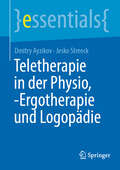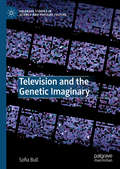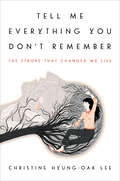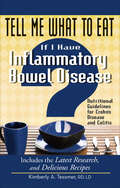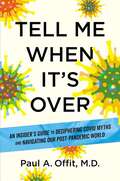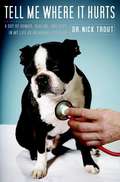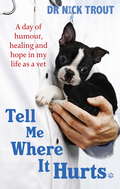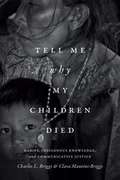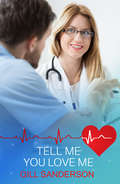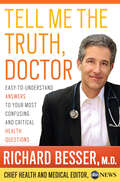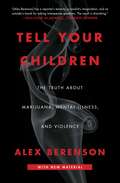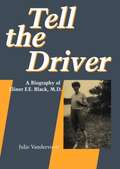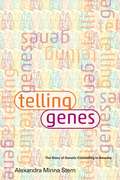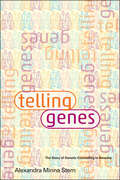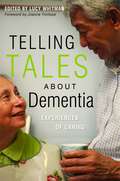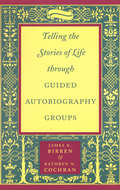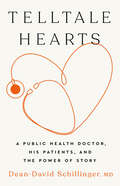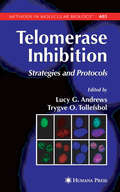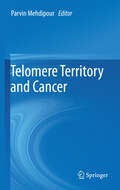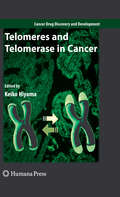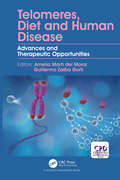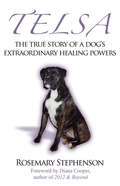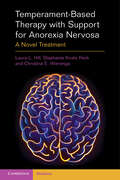- Table View
- List View
Teletherapie in der Physio, -Ergotherapie und Logopädie (essentials)
by Jesko Streeck Dmitry AyzikovDas essential bietet einen Leitfaden für Physiotherapeut*innen, Ergotherapeut*innen und Logopäd*innen, um mit Hilfe der Teletherapie eine qualitativ hochwertige Versorgung ermöglichen zu können. Erfahren Sie alles über die Vorteile und die praktische Umsetzung einer Behandlung auf Distanz. Mit klar strukturierten Anleitungen und praxisnahen Beispielen können Sie teletherapeutische Interventionen mühelos umsetzen. Wertvolle Tipps und konkrete Fallbeispiele machen dieses Buch zu einem unverzichtbaren Begleiter. Zudem werden theoretische Grundlagen verständlich erklärt, um Ihr Wissen über die Vorteile der Teletherapie zu vertiefen. Aus dem Inhalt: Neugestaltung der Therapie durch Telemedizin, Entscheidungsfindung zur Eignung eines Patienten für Teletherapie, was ist Teletherapie und welche Faktoren beeinflussen eine Behandlung?, Die Rolle der Therapeut*in im Genesungsprozess der Patient*innen, Onlinediagnostik und Differentialdiagnostik, Tipps und Tricks für die Gestaltung einer Teletherapeutischer Sitzung und ein Praxisbeispiel einer Behandlung auf Distanz.
Television and the Genetic Imaginary (Palgrave Studies in Science and Popular Culture)
by Sofia BullThis book examines the complex ways in which television articulates ideas about DNA in the early 21st century. Considering television’s distinct aesthetic and narrative forms, as well as its specific cultural roles, it identifies TV as a key site for the genetic imaginary. The book addresses the key themes of complexity and kinship, which function as nodes around which older essentialist notions about the human genome clash with newly emergent post-genomic sensibilities. Analysing a wide range of US and UK programmes, from science documentaries, science fiction serials and crime procedurals, to family history programmes, sitcoms and reality shows, Television and the Genetic Imaginary illustrates the extent to which molecular frameworks of understanding now permeate popular culture.
Television in the Nursing Home: A Case Study of the Media Consumption Routines and Strategies of Nursing Home Residents
by Wendy J HajjarTelevision in the Nursing Home: A Case Study of the Media Consumption Routines and Strategies of Nursing Home Residents is a three-stage ethnographic study of media use by the elderly in long-term care facilities. This research concludes that watching television is the most prevalent and pervasive activity for patients. Activity directors can now learn how television and media can offer diversion, enhancement of personality, awareness, and sociability to their patients and offers suggestions on roommate coordination, selection of appropriate media, and communication resources. Containing the latest knowledge involving communication and gerontology, Television in the Nursing Home will help you offer programs that will meet the demands of an expanding elderly population.Developed as a perspective for examining patterns of social interaction, Television in the Nursing Home gives suggestions on how you can use the media to create new activities for patients, maximizing the television as a resource for the elderly. You will gain valuable insight on: proof to dispel the myth that television in long-term patient care causes withdrawal and depression a breakthrough in the treatment of media and aging, enhancing media-based activities and the use and purchase of electronic equipment for care facilities studies on how and why television is the most accessible medium of communication information for the development of new media designed specifically for use by the elderly creation of media-centered activities that recognize the potential for therapeutic use of communication technologies in the nursing homeThe research presented in Television in the Nursing Home establishes the fact that television consumption, once thought to be problematic, should be seen as desirable and necessary. This important book also proves how television is a resource that provides comfort, self-expression, and sociality. This first-ever study will convince you that television and media use in long-term care is beneficial and essential to the wellness of your patients.
Tell Me Everything You Don't Remember: The Stroke That Changed My Life
by Christine Hyung-Oak LeeA memoir of reinvention after a stroke at age thirty-three.Christine Hyung-Oak Lee woke up with a headache on the morning of December 31, 2006. By that afternoon, she saw the world—quite literally—upside down. By New Year’s Day, she was unable to form a coherent sentence. And after hours in the ER, days in the hospital, and multiple questions and tests, her doctors informed her that she had had a stroke. For months afterward, Lee outsourced her memories to a journal, taking diligent notes to compensate for the thoughts she could no longer hold on to. It is from these notes that she has constructed this frank and compelling memoir.In a precise and captivating narrative, Lee navigates fearlessly between chronologies, weaving her childhood humiliations and joys together with the story of the early days of her marriage; and then later, in painstaking, painful, and unflinching detail, the account of her stroke and every upset—temporary or permanent—that it caused. Lee illuminates the connection between memory and identity in an honest, meditative, and truly funny manner, utterly devoid of self-pity. And as she recovers, she begins to realize that this unexpected and devastating event has provided a catalyst for coming to terms with her true self—and, in a way, has allowed her to become the person she’s always wanted to be.
Tell Me What to Eat If I Have Inflammatory Bowel Disease: Nutritional Guidelines for Crohn's Disease and Colitis (Tell Me What to Eat)
by Kimberly A. TessmerIBD isn’t a disease but rather the umbrella term for two major intestinal disorders that might sound more familiar: ulcerative colitis and Crohn’s disease. Both deal with inflammation in the digestive tract that can produce a wide range of unpleasant symptoms and lead to other health conditions.If you or a loved one are dealing with either of these conditions then you probably know that trying to control flare-ups—which bring on the symptoms—is the goal. Tessmer breaks down both of these conditions and provides reliable and practical advice on how eating right can help.Tell Me What to Eat If I Have Inflammatory Bowel Disease begins with an overview of both of these conditions (as well as Irritable Bowel Syndrome, or IBS), then guides you through diet recommendations that are based on the latest medical information.You will quickly learn what IBD is and what you can do to limit the impact of unwanted symptoms. In addition, you’ll get dozens of mouthwatering recipes from knowledgeable RDs that will make implementing the nutritional advice a bit easier.It’s all nutrition you can live with!
Tell Me When It's Over: An Insider's Guide To Deciphering Covid Myths And Navigating Our Post-pandemic World
by Paul A. OffitFrom one of the world’s top virologists, the definitive guide to understanding—and navigating—COVID-19. Three years on, COVID is clearly here to stay. So what do we do now? Drawing on his expertise as one of the world’s top virologists, Dr. Paul Offit helps weary readers address that crucial question in this brief, definitive guide. As a member of the FDA Vaccine Advisory Committee and a former member of the Advisory Committee for Immunization Practices to the CDC, Offit has been in the room for the creation of policies that have affected hundreds of millions of people.In these pages, he marshals the power of hindsight to offer a fascinating frontline look at where we were, where we are, and where we’re heading in the now-permanent fight against the disease. Accompanied by a companion website populated with breaking news and relevant commentary, this book contains everything you need to know to navigate COVID going forward. Offit addresses fundamental issues like boosters, immunity induced by natural infection, and what it means to be fully vaccinated. He explores the dueling origin stories of the disease, tracing today’s strident anti-vax rhetoric to twelve online sources and tracking the fallout. He breaks down long COVID—what it is, and what the known treatments are. And he looks to the future, revealing whether we can make a better vaccine, whether it should be mandated, and providing a crucial list of fourteen takeaways to eradicate further spread. Filled with pragmatic analysis and sensible advice, TELL ME WHEN IT’S OVER is for anyone interested in finding new solutions to the new normal.
Tell Me Where It Hurts: A Day of Humor, Healing, and Hope in My Life as an Animal Surgeon
by Nick TroutFrom the Book Jacket: It's 2:47 A.M., when Dr. Nick Trout takes the phone call that starts another hectic day at the Angell Animal Medical Center. Sage, a ten-year-old German shepherd, will die without emergency surgery for a serious stomach condition. Over the next twenty-four hours Dr. Trout fights for Sage's life, battles disease in the operating room, unravels tricky diagnoses, reassures frantic pet parents, and reflects on the humor, heartache, and inspiration in his life as an animal surgeon. And he wants to take you along for the ride... On the front lines of modern medicine, Tell Me Where It Hurts is a fascinating insider portrait of a veterinarian, his furry patients, and the blend of old-fashioned instincts and cutting-edge technology that defines pet care in the twenty-first century. For anyone who's ever wondered what goes on behind the scenes at your veterinarian's office, Tell Me Where It Hurts offers a vicarious journey through twenty-four intimate, eye-opening, heartrending hours at the preeminent Angell Animal Medical Center in Boston. You'll learn about the amazing progress of modern animal medicine, where organ transplants, joint replacements, and state-of-the-art cancer treatments have become more and more common. With these technological advances come controversies and complexities that Dr. Trout thoughtfully explores, such as how long (and at what cost) treatments should be given, how the Internet has changed pet care, and the rise in cosmetic surgery. You'll also be inspired by the heartwarming stories (continued on back flap) (continued from front flap) of struggle and survival filling these pages. With a wry and winning tone, Dr. Trout offers up hilarious and delightful anecdotes about cuddly (or not-so-cuddly) pets and their variously zany, desperate, and demanding owners. In total, Tell Me Where It Hurts offers a fascinating portrait of the comedy and drama, complexities and rewards involved with loving and healing animals. Part ER, part Dog Whisperer, and part House, this heartfelt and candid book shows that while the technology has changed since James Herriot's day, the humanity and compassion remain unchanged. If you've ever had a pet or special place in your heart for furry friends, Dr. Trout's irresistible book is for you. Nick Trout is a staff surgeon at the Angell Animal Medical Center and lives near Boston, Massachusetts.
Tell Me Where It Hurts: A Day of Humour, Healing and Hope in My Life as a Vet
by Dr Nick TroutIt's 2:47am when Dr Nick Trout, a British vet working in Boston, USA, is abruptly woken and called in to the Angell Memorial Animal Hospital to see if he can save the life of Sage, a ten year-old German Shephard with a critical stomach condition. The case is severe, the outlook bleak, and Dr Trout is her only chance. So begins an intimate and exhilarating journey into a typical day in a far from typical job.TELL ME WHERE IT HURTS takes the reader to the heart of the trials and tribulations of life as a veterinary surgeon, a life filled with heartbreak, triumph, anxiety, and of course, cuddly pets and their variously crazy, desperate, and demanding owners. The day's events come alive with Trout's breezy and companionable narration, and while he illustrates many of the issues pertinent to 21st century pet medicine, at its heart, the book reminds us that while the technology may have moved on from James Herriot's day, the essential characters, humour, and humanity remain the same as ever.
Tell Me Why My Children Died: Rabies, Indigenous Knowledge, and Communicative Justice
by Charles L. Briggs Clara Mantini-BriggsTell Me Why My Children Died tells the gripping story of indigenous leaders' efforts to identify a strange disease that killed thirty-two children and six young adults in a Venezuelan rain forest between 2007 and 2008. In this pathbreaking book, Charles L. Briggs and Clara Mantini-Briggs relay the nightmarish and difficult experiences of doctors, patients, parents, local leaders, healers, and epidemiologists; detail how journalists first created a smoke screen, then projected the epidemic worldwide; discuss the Chávez government's hesitant and sometimes ambivalent reactions; and narrate the eventual diagnosis of bat-transmitted rabies. The book provides a new framework for analyzing how the uneven distribution of rights to produce and circulate knowledge about health are wedded at the hip with health inequities. By recounting residents' quest to learn why their children died and documenting their creative approaches to democratizing health, the authors open up new ways to address some of global health's most intractable problems.
Tell Me You Love Me: A Thrilling Medical Romance (Medical Romances #15)
by Gill SandersonAnother captivating medical romance from best-selling author Gill Sanderson! Perfect for fans of Mia Faye, Laura Scott, Helen Scott Taylor, Grey's Anatomy and ER.Readers ADORE Gill's gripping medical romances!'A truly gifted writer with an enormous amount of talent and sensitivity' 5* author review'This book has all it takes... romance, thrills, high adventure...' 5* reader review '... it's a joy to lose yourself in such an interesting book' 5* reader reviewAbbey Fraser was the new doctor in charge of a team of divers working off the Scottish coast. It was fascinating work, at times dangerous. Perhaps more dangerous was her relationship with John Cameron, the Dive Master. She was attracted to the man and knew he was attracted to her. How could there be a future for them? John was a dedicated wanderer.Then came the most horrific coincidence possible. She discovered it was possible that John had been responsible for the underwater death of her husband! There would be more danger in a storm at sea before the two of them managed to sort out their problems.Don't miss Gill Sanderson's enthralling medical romances, including the A Lakeland Practice and the Good, Bad and Ugly series.
Tell Me You Love Me: A Thrilling Medical Romance (Medical Romances Ser.)
by Gill SandersonAnother captivating medical romance from best-selling author Gill Sanderson! Perfect for fans of Mia Faye, Laura Scott, Helen Scott Taylor, Grey's Anatomy and ER.Readers ADORE Gill's gripping medical romances!'A truly gifted writer with an enormous amount of talent and sensitivity' 5* author review'This book has all it takes... romance, thrills, high adventure...' 5* reader review '... it's a joy to lose yourself in such an interesting book' 5* reader reviewAbbey Fraser was the new doctor in charge of a team of divers working off the Scottish coast. It was fascinating work, at times dangerous. Perhaps more dangerous was her relationship with John Cameron, the Dive Master. She was attracted to the man and knew he was attracted to her. How could there be a future for them? John was a dedicated wanderer.Then came the most horrific coincidence possible. She discovered it was possible that John had been responsible for the underwater death of her husband! There would be more danger in a storm at sea before the two of them managed to sort out their problems.Don't miss Gill Sanderson's enthralling medical romances, including the A Lakeland Practice and the Good, Bad and Ugly series.
Tell Me the Truth, Doctor: Easy-to-Understand Answers to Your Most Confusing and Critical Health Questions
by Richard Besser"Hey, Doc--Got a Minute?"No matter where Dr. Richard Besser goes, a day doesn't go by without someone stopping him to ask that question. Often, that person is one of the millions who have come to rely on the vital information he shares on Good Morning America, World News with Diane Sawyer, and Nightline. Now, in response to thousands of inquiries from viewers, Dr. Besser has written his first book--a comprehensive health guide that will both inform and surprise as he deciphers fact from fiction for nearly seventy confusing medical questions, including:- "Should I take a daily aspirin to prevent a heart attack, stroke, or cancer?"- "If my doctors order a lot of tests, does that mean they're more thorough?" - "Do I need thirty minutes of exercise a day to stay healthy?"Recognizing the astonishing amount of misinformation that many important health decisions are based upon, Dr. Besser's commitment to delivering the truth is critical. He isn't afraid to challenge the status quo--or the interests within the health care industry--to provide the knowledge you need to take control of your health. Eager to help you make the choices that are right for YOU, he organizes his easy-to-understand answers into six lifestyle categories, including diet and nutrition; exercise and fitness; vitamins, supplements, and medicines; beating illness and injury; and navigating the perplexing world of health care, as well as a chapter dedicated to the questions you wished you asked before your doctor walks out the door.Throughout the book, Dr. Besser smashes myths while translating invaluable information into problem-solving advice you can use, including a "Dr. B's Bottom Line" at the end of each topic. As accessible as it is empowering, Dr. Besser's Tell Me the Truth, Doctor is a necessary addition to every home, office, and dorm room. "Besser . . . ably analyzes popular myths (the "Freshman Fifteen"), considers pros and cons (HRT and statins), and mostly takes unequivocal stands on the issues. . . . Quite often, his comments and suggestions surprise. . . . Particularly helpful are his guidelines for avoiding the harmful effects of health care and hospitalization." --Publishers Weekly Richard Besser, MD, ABC News' Chief Health and Medical Editor, provides medical analysis and commentary for all ABC News broadcasts and platforms, including World News with Diane Sawyer, Good Morning America, and Nightline, as well as many other news/entertainment programs. me he led the CDC's response to the H1N1 influenza outbreak. He has taught and trained doctors at the University of California, San Diego and is a visiting fellow at the Harvard School of Public Health. Most important, for more than twenty-five years he has practiced medicine, giving his patients and their families straightforward, commonsense advice.
Tell Your Children: The Truth About Marijuana, Mental Illness, and Violence
by Alex BerensonAn eye-opening report from an award-winning author and former New York Times reporter reveals the link between teenage marijuana use and mental illness, and a hidden epidemic of violence caused by the drug—facts the media have ignored as the United States rushes to legalize cannabis.Recreational marijuana is now legal in nine states. Almost all Americans believe the drug should be legal for medical use. Advocates argue cannabis can help everyone from veterans to cancer sufferers. But legalization has been built on myths– that marijuana arrests fill prisons; that most doctors want to use cannabis as medicine; that it can somehow stem the opiate epidemic; that it is not just harmless but beneficial for mental health. In this meticulously reported book, Alex Berenson, a former New York Times reporter, explodes those myths: • Almost no one is in prison for marijuana; • A tiny fraction of doctors write most authorizations for medical marijuana, mostly for people who have already used; • Marijuana use is linked to opiate and cocaine use. Since 2008, the US and Canada have seen soaring marijuana use and an opiate epidemic. Britain has falling marijuana use and no epidemic; • Most of all, THC—the chemical in marijuana responsible for the drug’s high—can cause psychotic episodes. After decades of studies, scientists no longer seriously debate if marijuana causes psychosis. Psychosis brings violence, and cannabis-linked violence is spreading. In the four states that first legalized, murders have risen 25 percent since legalization, even more than the recent national increase. In Uruguay, which allowed retail sales in July 2017, murders have soared this year. Berenson’s reporting ranges from the London institute that is home to the scientists who helped prove the cannabis-psychosis link to the Colorado prison where a man now serves a thirty-year sentence after eating a THC-laced candy bar and killing his wife. He sticks to the facts, and they are devastating. With the US already gripped by one drug epidemic, this book will make readers reconsider if marijuana use is worth the risk.
Tell the Driver: A Biography of Elinor F.E. Black, MD
by Julie VandervoortA biography of Dr. Elinor Black (1905-1982), the first Canadian woman to gain membership in the Royal College of Obstetricians and Gynecologists in London.
Telling Genes: The Story Of Genetic Counseling In America
by Alexandra SternFor sixty years genetic counselors have served as the messengers of important information about the risks, realities, and perceptions of genetic conditions. More than 2,500 certified genetic counselors in the United States work in clinics, community and teaching hospitals, public health departments, private biotech companies, and universities. Telling Genes considers the purpose of genetic counseling for twenty-first century families and society and places the field into its historical context. Genetic counselors educate physicians, scientific researchers, and prospective parents about the role of genetics in inherited disease. They are responsible for reliably translating test results and technical data for a diverse clientele, using scientific acumen and human empathy to help people make informed decisions about genomic medicine. Alexandra Minna Stern traces the development of genetic counseling from the eugenics movement of the early twentieth century to the current era of human genomics. Drawing from archival records, patient files, and oral histories, Stern presents the fascinating story of the growth of genetic counseling practices, principles, and professionals.
Telling Genes: The Story of Genetic Counseling in America
by Alexandra Minna SternThe history of contemporary genetic counseling, including its medical, personal, and ethical dimensions.Winner of the CHOICE Outstanding Academic Title of the Choice ACRLFor sixty years genetic counselors have served as the messengers of important information about the risks, realities, and perceptions of genetic conditions. More than 2,500 certified genetic counselors in the United States work in clinics, community and teaching hospitals, public health departments, private biotech companies, and universities. Telling Genes considers the purpose of genetic counseling for twenty-first century families and society and places the field into its historical context.Genetic counselors educate physicians, scientific researchers, and prospective parents about the role of genetics in inherited disease. They are responsible for reliably translating test results and technical data for a diverse clientele, using scientific acumen and human empathy to help people make informed decisions about genomic medicine.Alexandra Minna Stern traces the development of genetic counseling from the eugenics movement of the early twentieth century to the current era of human genomics. Drawing from archival records, patient files, and oral histories, Stern presents the fascinating story of the growth of genetic counseling practices, principles, and professionals.
Telling Tales About Dementia
by Edited by Lucy WhitmanHow does it feel when someone you love develops dementia? How do you cope with the shock, the stress and the grief? Can you be sure that you and your family will receive the support you need? In Telling Tales About Dementia, thirty carers from different backgrounds and in different circumstances share their experiences of caring for a parent, partner or friend with dementia. They speak from the heart about love and loss: 'I still find it hard to believe that Alzheimer's has happened to us,' writes one contributor, 'as if we were sent the wrong script. ' The stories told here vividly reflect the tragedy of dementia, the gravity of loss, and instances of unsatisfactory diagnosis, treatment and care. But they contain hope and optimism too: clear indications that the quality of people's lives can be enhanced by sensitive support services, by improved understanding of the impact of dementia, by recognising the importance of valuing us all as human beings, and by embracing and sustaining the connections between us. This unique collection of personal accounts will be an engaging read for anyone affected by dementia in a personal or professional context, including relatives of people with dementia, social workers, medical practitioners and care staff.
Telling the Stories of Life through Guided Autobiography Groups
by James E. Birren Kathryn N. CochranTelling the Stories of Life through Guided Autobiography Groups, based on James Birren's 25 years of conducting autobiography groups, discusses all the topics an organizer faces while developing a program for adults who want to recall and write down their life histories. This book is ideal for adult education programs, church groups, social workers, psychologists, gerontologists, and others who work with adults who might be interested in exploring, recording, or sharing their personal histories. It helps professionals and trained workshop leaders at community centers, senior centers, schools and other settings guide group participants in exploring major themes of their lives so that they can organize and write their stories and share them in a group with others on the same journey. This exercise is rewarding for adults of any age in a period of transition or with interest in gaining insight from their own stories. Personal development and a feeling of connection to other participants and their stories is a natural outcome of this process. This book provides background material and detailed lesson plans for those who wish to develop and lead an autobiography group.The authors explain the concept of guided autobiography, discuss the benefits to the group participants, and provide logistical information on how to plan, organize, and set up a group. An appendix provides exercises, handouts, and suggested adaptations for specific groups. The book also explains a systematic method of priming memories, including the history of family and of one's life work, the role of money, health and the body, and ideas about death.At a time when rapid change has created a widespread yearning to write down and exchange personal accounts, sharing life stories can reveal a great deal about how we have come to be the persons we are. Telling the Stories of Life through Guided Autobiography Groups shows how to organize, record, and share life experiences through a proven and effective technique.
Telltale Hearts: A Public Health Doctor, His Patients, and the Power of Story
by Dean-David SchillingerIn this illuminating work, a doctor and public health advocate reveals what his patients have taught him about patience and healing. For over three decades, Dr. Dean-David Schillinger has served in one of the country&’s busiest and most important public hospitals. A public health leader and primary care physician for underserved patients, Schillinger learned that high-tech tests and novel medications are often not enough to save lives. Rather, accurate diagnosis, treatment and true healing come from listening deeply to patients and their stories. In Telltale Hearts, Schillinger reveals what is lost when patients&’ stories are ignored or overlooked, and how much is gained when these stories are actively elicited. The stories themselves, at times shocking and always revelatory, disclose secrets, prompt awe, forge unexpected connections, and even catalyze public health action.Telltale Hearts serves as a call to action, urging us to reshape public policy to improve the nation's health.
Telomerase Inhibition
by Trygve O. Tollefsbol Lucy AndrewsThis volume presents a compendium of the most recent and advanced methods applied to the rapidly expanding field of telomerase inhibition. The techniques described provide the researcher with a diverse and comprehensive set of tools for the study of telomerase inhibition. The volume is aimed at biochemists, molecular biologists, cancer researchers, and geneticists.
Telomere Territory and Cancer
by Parvin MehdipourTiming, racing, combating, struggling and targeting are some actions through which cellular fate could be reflected and evaluated. Interaction between cell territory and environment occur during pre-embryonic, fetal development, and post-natal periods. What the researchers observe as the outcome of telomeres behavior is only the peak of an ice mountain within a stormy ocean. Cellular life depends on programmed behavior of telomeres, capable to surprise the cells. Telomeres provide an introduction to the history of our cells which govern the quality of life and status of health. Telomeres as the cooperative territory are capable of stabilizing the chromosomal territory. The status of telomeres reflects the key information, announcing the real age of individuals, and may be a valuable marker for prognosis and predicting cancer. Telomere territory is characterized with a multi-disciplinary manner. Therefore, this book is aimed to offer a wide range of chapters, hoping to be useful for diverse audiences, including hematologists-oncologists, radiotherapists, surgeons, cancer researchers, and all the sectors who affect the macro- and micro- environmental domains. Finally, telomeres are sensitive, cooperative, and trustable targets. It is worth to state that 'telomeres are messengers of NATURE', let's to know them as they are.
Telomeres and Telomerase in Cancer
by Keiko HiyamaTelomerase, an enzyme that maintains telomeres and endows eukaryotic cells with immortality, was first discovered in tetrahymena in 1985. In 1990s, it was proven that this enzyme also plays a key role in the infinite proliferation of human cancer cells. Now telomere and telomerase are widely accepted as important factors involved in cancer biology, and as promising diagnostic tools and therapeutic targets. Recently, role of telomerase in "cancer stem cells" has become another attractive story. Until now, there are several good books on telomere and telomerase focusing on biology in ciliates, yeasts, and mouse or basic sciences in human, providing basic scientists or students with updated knowledge.
Telomeres, Diet and Human Disease: Advances and Therapeutic Opportunities
by Amelia Marti Guillermo ZalbaThe maintenance of telomeres—repetitive sequences at the end of chromosome—is essential to health. Dysfunction in telomere maintenance pathways plays a role in aging, cancer, atherosclerosis and other diseases. This has led to telomere maintenance as a prime target for patient therapies. This book describes the advances in telomere research as it applies to human health and especially how lifestyle and dietary factors could modify the telomerase maintenance process. The book examines the mechanisms involved, the primary of which are oxidative stress and the role of sirtuins, and how they can be modified by dietary patterns such as Mediterranean diet.
Telsa
by Diana Cooper Rosemary StephensonThrough this touching account of the life and work of a boxer named Telsa, the powerful relationship between humans and animals is explored, and the unconditional love shown by a pet is demonstrated as a force that can improve the emotional, mental, and physical well-being of the people around them. The beloved pet of a spiritual healer, Telsa became instrumental in amplifying healing energies throughout her life and even after her passing. Her connection with others and the world around her was unique and immensely positive, and the book follows her story, from her life as a puppy and her invaluable service to nursing home patients to Telsa''s connection to her owner in the after-life.
Temperament Based Therapy with Support for Anorexia Nervosa: A Novel Treatment
by Laura L. Hill Stephanie Knatz Peck Christina E. WierengaAnorexia Nervosa has one of the highest death rates of all mental illnesses and one of the poorest treatment outcomes. However, one novel treatment, the neurobiologically-based treatment Temperament-Based Therapy with Supports (TBT-S), works with clients' temperament and traits to motivate change, ultimately managing and reducing symptoms. This practical and accessible book is the first guide to delivering TBT-S that addresses the underlying traits leading to symptoms of anorexia nervosa and helps people to manage symptoms long-term. It offers background information on the role of temperament in anorexia nervosa, the development of the TBT-S protocol and the evidence gathered. Chapters also covers how to augment this therapy into existing treatment. A valuable resource for clinicians involved in the treatment of anorexia nervosa, including psychologists, psychiatrists, psychotherapists, specialist nurses, dieticians, and educators.
